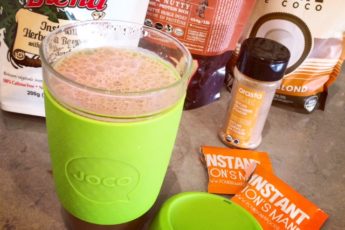If you want to add some healthy new flavours to your meals, it’s time to move beyond your salt and pepper shakers. There’s an entire world’s worth of herbs and spices out there for you to try, and they’re full of flavour and nutritional benefits. Many of these spices instantly bring to mind a particular part of the world or type of cuisine, – lemongrass goes well with Thai food and curry powder goes well with Indian cuisine. But that doesn’t mean that you can only use these spices for their authentic dishes. Have fun exploring the many different, innovative dishes that you can create using spices and let your taste buds be your tour guide as you experiment with new tastes in the kitchen.
With the many options of herbs and spices that there are to choose from, make sure your spice rack is stocked with these six essential and healthy ingredients to get started:
1. Turmeric
Health benefits: Turmeric is a concentrated source of anti-inflammatory properties (curcumin) are shown to promote liver function and heart health.
Nutritional benefits: Turmeric is rich in iron and manganese, fibre, B6, and potassium, and is the highest known source of beta carotene. The bright yellow pigment of this spice might have a role in halting the development of colon cancer.
How to use it: Add turmeric to salad dressings, mix it into brown rice, add some extra turmeric into curry for even more flavour, and add it to lentils or Indian-themed dishes.
2. Cumin
Health benefits: Cumin soothes the digestive system, improves liver function, helps you absorb nutrients from other foods, and relieves abdominal bloating, gas and colic as well as digestive-related migraines and headaches.
Nutritional benefits: Cumin is a good source of iron and helps to stimulate the secretion of pancreatic enzymes.
How to use it: Add this spice to black pepper and honey to flavour vegetables, boil the seeds for a warming tea, add it to legumes for spice and flavour, add it to brown rice with apricots and almonds, add it to sautéed vegetables, and use it in dips, pilafs, and soups.
3. Parsley
Health benefits: Parsley contains volatile oils that have been shown to inhibit tumour formation, and has flavonoids that function as antioxidants that prevent oxygen-based damage to cells.
Nutritional benefits: Parsley is loaded with iron, calcium, magnesium, potassium fibre, vitamins E and C, manganese, and tryptophan. This herb is medicinal for the stomach, treats anemia and rheumatism, promotes lactation, and helps contract the uterus.
How to use it: Use parsley in tabbouleh, chop and sprinkle on top of soup, and you can use it to make pesto.
4. Cinnamon
Health benefits:Cinnamon blocks inflammation and bacterial growth, as well as helps to regulate blood sugar.
Nutritional benefits: Cinnamon is a source of calcium, manganese, dietary fibre, and iron. It helps to increase digestive fluid secretion and relieve intestinal gas. This spice counteracts congestion and aids blood circulation, and its aroma relieves tension and helps steady the nerves
How to use it: Sprinkle cinnamon on toast with honey, add it to warmed rice milk with honey, add it to water when cooking quinoa, or add it to black beans for burritos or nachos.
5. Ginger
Health benefits: Ginger soothes the stomach and reduces nausea, as well as relaxes the intestinal tract and reduces gas. Ginger prevents motion sickness (especially seasickness) as well as reduces nausea and vomiting during pregnancy. It contains anti-inflammatory compounds called gingerols, which is why people with arthritis may experience reduced pain and improvements in their mobility when they consume ginger regularly.
Nutritional benefits: Ginger contains a source of magnesium, B6, potassium, manganese, and copper. By increasing circulation, ginger helps you cleanse through the skin, bowels and kidneys. It is anti-inflammatory and helps destroy many intestinal parasites.
How to use it: Add ginger to vegetables, use it to make ginger lemonade, add it to rice dishes with sesame seeds and strips of nori, combine it with tamari, sesame oil and garlic to make a delicious salad dressing, or add it to sautéed vegetables.
6. Oregano
Health benefits: The volatile oils in oregano can inhibit the growth of bacteria. The numerous phytonutrients found in this herb are antioxidants that can prevent oxygen-based damage to the cell structures. On a per gram, fresh-weight basis, oregano has demonstrated 42 times more antioxidant capacity than apples, 30 times more than potatoes, 12 times more than oranges, and four times more than blueberries.
Nutritional benefits: Oregano is a source of fibre, iron, manganese, calcium, vitamins C and A, and omega-3 fatty acids
How to use it: Garnish pizza with fresh oregano, add the nutritious herb to sautéed mushrooms and onions, add a few fresh sprigs to a container of olive oil to infuse it, or add it to omelettes.
This article was originally featured on Chatelaine.
Join us for two delicious spice infused classes: Moroccan Flavours & Indian Inspiration!
Smoky Eggplant Dip
- Yield: 10 Servings
- Prep: 60 mins
- Cook: 10 mins
- Ready In: 1 hr 10 mins
Eggplants are known as aubergines. Eggplants are a specialty item and a true staple to Mediterranean and Moroccan cuisine. When it is roasted it derives a smoked flavour and makes for hearty dishes like dips, stews and sauces. Eggplants can also be sliced up and roasted for an excellent side dish.
Ingredients
Instructions
1. Preheat oven to 375F. Slice off the tip of a head of garlic and place in a piece of foil, cover with a dash of sea salt and a 1 teaspoon olive oil. Wrap up and bake on 350F for 1 hour.
2. Roast the eggplants directly over flame on stove, or in an oven until the skin blisters and the flesh feels very soft.
3. Place in a large metal bowl and seal with plastic wrap for 20 minutes or so to allow the skin to loosen.
4. When the eggplants are cool enough to work with, remove the skin, seeds and cut into small dice.
5. Wash the spinach and add to a pot with a small amount of water. Cook until wilted.
6. In a food processor, mix the garlic, lemon juice, cumin, salt, tahini and olive oil together.
7. In a large bowl, add the spinach mixture to the eggplant and mix well. Add more salt to taste.



